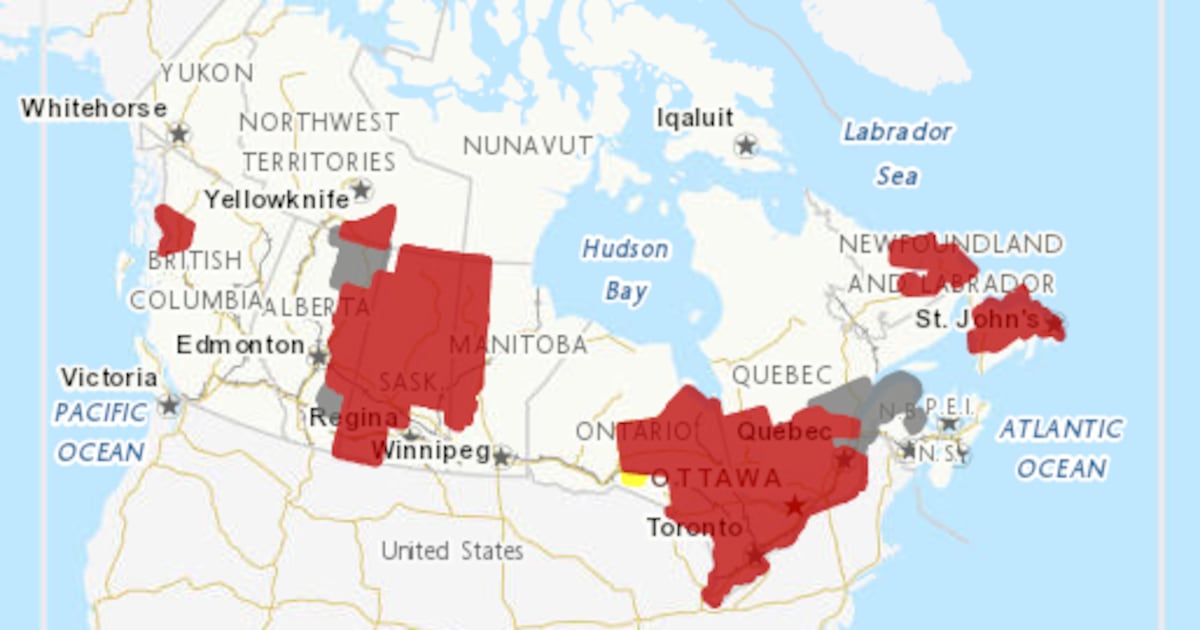Environment Canada has issued hundreds of heat and air quality warnings this weekend as high temperatures and wildfire smoke continue to impact regions across the country.
Heat warnings
In many parts of Canada, daytime temperatures are projected to rise above 30 C and expected to last for the next few days, prompting heat warnings in Northwest Territories as well as the provinces of Ontario, Quebec and Newfoundland and Labrador.
Forecasts show daytime lows just above 20 C, and humidex values of 35 to 40 expected in Ontario and Quebec.
With the prolonged, high temperatures, there is an elevated risk of heat-related illnesses, such as heat stroke or heat exhaustion, the department notes.
Environment Canada is asking individuals to watch for signs of these conditions, as extreme heat can pose risks to anyone’s health.
Symptoms of heat exhaustion may include headache, nausea, dizziness, thirst, dark-coloured urine and intense fatigue, while heat stroke can cause red and hot skin, dizziness, nausea, confusion and a change in consciousness.
To protect yourself from heat-related illness, Environment Canada recommends drinking water often, even before you feel thirsty to help stay hydrated. Closing blinds or shades, opening windows if outside is cooler than inside, using air conditioning or fans and moving to a cooler area of your living space are also recommended.
If your living space is hot, the warning recommends moving to a cool public space.
Environment Canada warns to plan and schedule outdoor activities during the coolest parts of the day, limiting direct exposure to the sun and heat, wearing lightweight, light-coloured, loose-fitting clothing and a wide-brimmed hat.
If you, or someone around you, is experiencing heat stroke, call 911 immediately.
Never leave people or pets inside a parked vehicle, the warning adds.
Air quality warnings
Smoke from wildfires predominately in the northern Prairies continues to cause poor air quality and reduced visibility across Canada.
According to the latest data compiled by the Canadian Interagency Forest Fire Centre (CIFFC), there are currently 715 active wildfires in Canada, totaling 4,255 wildfires this season.
Wildfires from Canada’s 2025 wildfire season have burned through 72,000 square kilometres of land — making it the second-worst season on record behind 2023, when approximately 173,000 square kilometres burned.
With the continued poor air quality, Environment Canada has issued warnings in provinces like Alberta, Saskatchewan, Manitoba, Northwest Territories, New Brunswick and Newfoundland and Labrador.
While people more likely to be impacted by wildfire smoke are those aged 65 and older, pregnant people, infants and young children and people with pre-existing health conditions, everyone’s health is at risk, the warning notes.
Individuals in affected areas are advised to avoid strenuous activities outdoors, to reschedule or cancel outdoor sports, activities and events and to seek medical attention in the event of a medical emergency.
Mild symptoms can include eye, nose and throat irritation, headaches or a mild cough, while more serious but less common symptoms include wheezing, chest pains or severe cough.
When indoors, Environment Canada recommends protecting your indoor air from wildfire smoke by keeping windows and doors closed as much as possible, using a clean, good quality air filter in your ventilation system and/or a certified portable air cleaner that can filter fine particles.
Rainfall warnings
Rainfall warnings have also been issued in provinces like British Columbia, Manitoba and Saskatchewan, with heavy rain expected to last through Sunday.
According to the warning, heavy rain can cause flash floods, water pooling on roads and localized flooding in low-lying areas and reduce visibility while driving.
For more information on active weather alerts in your region, see Environment Canada’s interactive map here.

